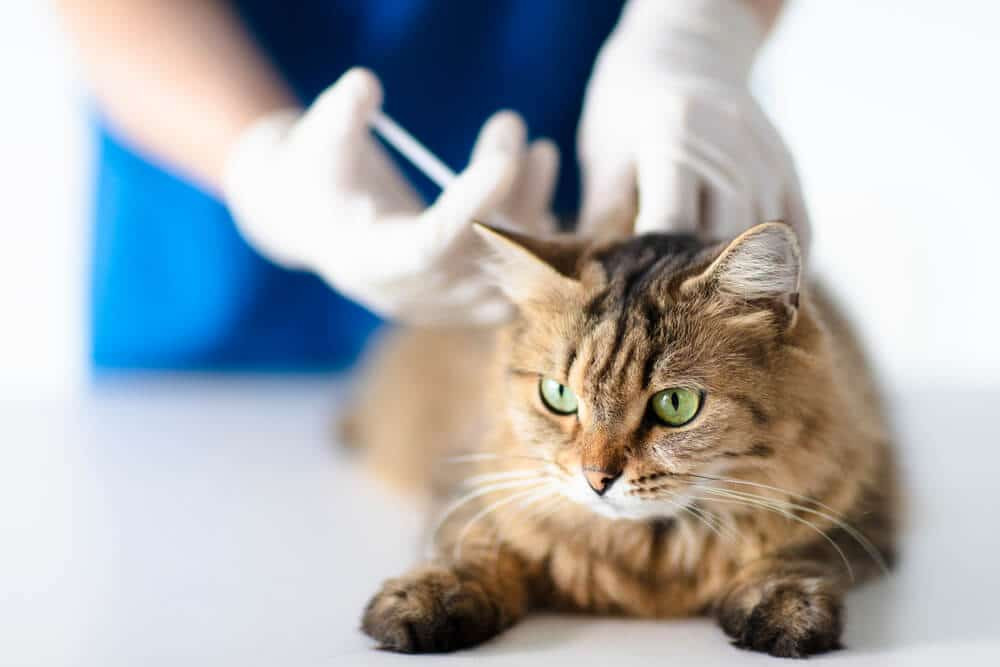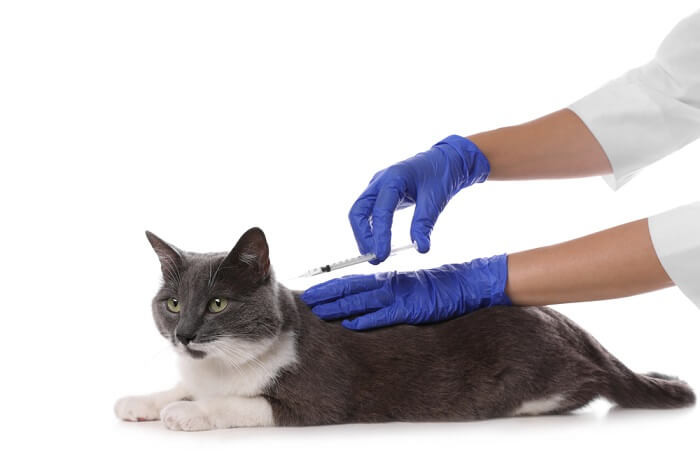 Cerenia injection for cats being prepared by a veterinarian
Cerenia injection for cats being prepared by a veterinarian
Cerenia, known generically as maropitant citrate, is a widely recognized medication in veterinary medicine. Developed by Zoetis, this neurokinin-1 (NK1) receptor antagonist was initially formulated for dogs to combat motion sickness and vomiting. However, its effectiveness and safety have led to its approval and widespread use for managing similar issues in cats.
Understanding Cerenia for Cats: Key Facts
Medication Type: Antiemetic
Form: Tablet, Injection
Prescription Required: Yes
FDA Approved: Yes
Approved for Life Stage: Cats 16 Weeks and Older
Brand Name: Cerenia
Generic Name: Maropitant Citrate
Available Dosages:
- Tablets: 16 mg, 24 mg, 60 mg, & 160 mg
- Injection: 10 mg/ml
Injection Expiration: 3 Months Refrigerated
The Food and Drug Administration (FDA) first approved Cerenia for use in dogs in 2007, and later extended this approval to cats in 2012. Since then, Cerenia has become a staple in veterinary clinics globally, prized for its ability to effectively control vomiting and nausea in feline patients.
How Cerenia Works to Stop Vomiting in Cats
Cerenia’s primary function in cats is as an antiemetic, meaning it’s designed to prevent and treat nausea and vomiting. It achieves this by targeting the vomiting pathways within the brain.
Vomiting is a complex reflex initiated when the chemoreceptor trigger zone (CRTZ) in the brain detects emetic stimuli and sends signals to the vomiting center, located in the medulla oblongata. Cerenia intervenes in this process by blocking these signals, thereby preventing the vomiting reflex from being triggered.
Specifically, Cerenia is classified as a neurokinin-1 (NK1) receptor antagonist. It works by preventing a neurotransmitter called substance P from binding to NK1 receptors. These receptors are crucial in initiating vomiting and are found in several key locations: the CRTZ, the vomiting center in the brain, and the vagus nerve, which is closely associated with the gastrointestinal tract.
Substance P plays a central role in the vomiting pathway at all three of these locations. Cerenia’s molecular structure is similar to substance P, allowing it to bind to NK1 receptors. However, unlike substance P, Cerenia does not stimulate these receptors. Instead, it blocks substance P from binding, effectively halting the signals that lead to vomiting.
This multi-site action – working in the brain and the digestive tract – is what makes Cerenia such a potent and effective antiemetic for cats.
Common and Important Uses of Cerenia for Cats
 Cat in a carrier, illustrating motion sickness prevention with Cerenia
Cat in a carrier, illustrating motion sickness prevention with Cerenia
Cerenia is versatile and used in a variety of situations to manage nausea and vomiting in cats. Here are some of the most common applications:
- Motion Sickness: Cerenia is highly effective in preventing vomiting associated with motion sickness in cats during travel. Administering Cerenia before a car ride or other travel can significantly reduce the likelihood of your cat becoming nauseous and vomiting.
- Chronic Kidney Disease-Related Vomiting: Cats suffering from chronic renal failure often experience nausea and vomiting as a result of the build-up of toxins in their system. Cerenia can provide long-term relief from this distressing symptom, improving their quality of life.
- Acute Vomiting Episodes: Veterinarians frequently use Cerenia to quickly control acute episodes of vomiting, regardless of the underlying cause. This rapid action helps to prevent dehydration and discomfort associated with vomiting.
- Post-Operative Nausea and Vomiting (PONV): Anesthesia and surgery can often induce nausea and vomiting in cats. Cerenia is commonly administered before or after surgical procedures to prevent PONV, ensuring a smoother recovery.
- Pain Relief: Beyond its antiemetic properties, Cerenia also has mild analgesic effects. It is sometimes used as part of a multimodal pain management strategy, particularly for visceral pain associated with surgical procedures like spaying. This pain-relieving effect can contribute to reducing the amount of general anesthetic required, known as an anesthetic-sparing effect.
- Pruritus (Itchiness) Management: Emerging research indicates that Cerenia can help alleviate itchiness in cats suffering from non-flea, non-food-induced hypersensitivity dermatitis. While not its primary use, this application highlights the drug’s broader potential.
Administration of Cerenia: Injections and Tablets
 Veterinarian giving a cat an injection of Cerenia
Veterinarian giving a cat an injection of Cerenia
Cerenia is available in two formulations for cats: injectable and tablets.
Cerenia Injections for Cats
The injectable form of Cerenia is frequently used in veterinary clinics due to its rapid onset of action. The standard dosage for Cerenia injection in cats is 1 mg/kg of body weight, which equates to 1 ml per 10 kg of body weight. It is typically administered subcutaneously (under the skin), but can also be given intravenously (directly into the vein) by a veterinarian. Treatment can be administered once daily for up to five consecutive days.
Refrigerating Cerenia injectable solution prior to administration may help to lessen the transient pain sensation that some cats experience upon injection.
Cerenia Tablets for Cats
While Cerenia tablets are officially formulated and licensed for oral use in dogs, some veterinarians may prescribe them off-label for cats in specific situations. It’s crucial to understand that Cerenia tablets are not specifically licensed for use in cats, and their use should only be considered under the direct guidance and recommendation of a veterinarian. Your vet will determine if tablets are appropriate for your cat’s condition and calculate the correct dosage.
Potential Side Effects of Cerenia in Cats
The most commonly reported side effect of Cerenia injection in cats is transient pain or vocalization at the injection site, affecting approximately one in three cats. This discomfort usually subsides within a few minutes without requiring treatment. As mentioned earlier, refrigerating the injectable solution can help minimize this reaction.
Other, less common side effects associated with Cerenia injection may include:
- Fever (pyrexia)
- Dehydration
- Lethargy
- Anorexia (loss of appetite)
- Hematuria (blood in the urine)
- Hypersalivation (excessive drooling)
- Swelling at the injection site
These rarer side effects are reported in less than 1-2% of treated cats. As with any medication, the possibility of an allergic reaction, though uncommon, exists.
For pet owners handling Cerenia tablets, it’s important to be aware that topical exposure to the drug may cause allergic skin reactions in sensitized individuals. It is advisable to wash hands thoroughly after administering Cerenia tablets to your cat.
Drug Interactions with Cerenia
Cerenia is known to be a protein-bound drug. This means that it attaches to proteins in the bloodstream. The concurrent use of Cerenia with other protein-bound drugs has not been extensively studied. This category of drugs includes non-steroidal anti-inflammatory drugs (NSAIDs), as well as certain cardiac and anticonvulsant medications.
Therefore, caution is advised when administering Cerenia to cats already receiving other protein-bound medications. Close monitoring by a veterinarian is recommended to watch for any potential adverse interactions or changes in drug efficacy.
Important Risk Factors and Precautions for Cerenia Use
Certain conditions and life stages require careful consideration when using Cerenia in cats:
- Pregnancy and Lactation: The safety of Cerenia has not been established in pregnant or lactating cats. Therefore, its use is generally avoided in these populations unless deemed absolutely necessary by a veterinarian.
- Kittens Under 16 Weeks: Cerenia is not approved for use in kittens younger than sixteen weeks of age.
- Gastrointestinal Obstruction or Toxin Ingestion: Cerenia should be used cautiously in cases of vomiting where gastrointestinal obstruction or toxin ingestion is suspected as the underlying cause. Masking vomiting in these situations could delay diagnosis and appropriate treatment of the primary condition.
- Hepatic Dysfunction (Liver Disease): Cerenia is metabolized by the liver. Cats with liver disease (hepatic dysfunction) may metabolize the drug more slowly. Veterinarians typically recommend a dose reduction of 25-50% in cats with liver problems to avoid potential drug accumulation and adverse effects.
Veterinarians carefully consider the potential risks and benefits of Cerenia in each individual case to ensure its safe and effective use.
Conclusion: Cerenia as a Valuable Antiemetic for Cats
Cerenia (maropitant) is a highly valuable medication in veterinary medicine, providing effective relief from acute vomiting and nausea in cats caused by various factors. Its potent antiemetic action and generally good safety profile make it a preferred choice for veterinarians managing feline vomiting. However, it is essential to remember that Cerenia is a prescription medication and should only be used under veterinary guidance to ensure appropriate use and minimize potential risks.
Drug Dosing Disclaimer: Dosage information provided is for informational purposes only and based on FDA-approved guidelines for cats. Off-label medication use and specific dosing adjustments should always be determined and directed by a qualified veterinarian. Consult with your veterinarian to determine the most appropriate medication and dosage for your cat’s individual needs and health condition. Never adjust your cat’s medication dosage without professional veterinary advice.
Frequently Asked Questions About Cerenia for Cats
Will Cerenia completely stop my cat’s vomiting?
Cerenia is a highly effective antiemetic and is often successful in stopping vomiting in cats. However, it’s crucial to understand that Cerenia is a prescription medication that must be prescribed by a veterinarian. It is not a one-size-fits-all solution and may not be appropriate for every cause of vomiting in cats. Your veterinarian will determine if Cerenia is the right choice based on your cat’s specific condition.
Can Cerenia help a cat that is experiencing weight loss?
Weight loss in cats can have numerous underlying causes. While Cerenia can be beneficial for cats whose weight loss is partially attributed to persistent vomiting and nausea, it may not address weight loss stemming from other issues. Therefore, Cerenia should only be used for weight loss when specifically recommended by a veterinarian after a proper diagnosis.
How safe is Cerenia for cats?
Cerenia is considered a safe medication for cats when used as directed by a veterinarian. The most common side effect, injection site pain, is usually mild and temporary. Studies have shown that even when cats were given significantly higher doses of Cerenia than recommended, they did not exhibit serious adverse effects.
How quickly does Cerenia start working?
Cerenia is known for its rapid onset of action. It typically begins to take effect within 30 minutes to two hours after administration.
What should I do if I miss a dose of Cerenia?
If you miss a scheduled daily dose of Cerenia, administer the normal dose as soon as you remember, provided it is not too close to the next scheduled dose. If it is almost time for the next dose, skip the missed dose and continue with the regular dosing schedule. Do not double the dose to make up for a missed one.
Does Cerenia cause sleepiness in cats?
Sleepiness or lethargy is a rare side effect of Cerenia in cats. It occurs in less than 2% of cats treated with the medication.
Where can I purchase Cerenia for my cat?
Cerenia is a prescription-only medication. You can only obtain Cerenia through a licensed veterinarian. It cannot be purchased over-the-counter. Your veterinarian will need to examine your cat and provide a prescription if Cerenia is deemed necessary and appropriate.


